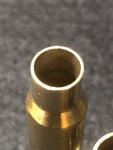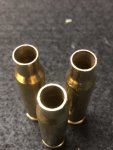I am wondering how many here bother to chamfer and deburr following trimming of brass in general and if it matters what gun you are reloading for, ie cheap reloads for an AR versus single stage precision reloads for a bolt gun.
It seems that more often then not brass I get advertised as fully processed and ready to reload is trimmed but not chamfered. I am trying to determine whether I am putting too much emphasis on this step or if my brass sources are simply skipping it in the name of expediency.
See the pics below, clearly no chamfer. When seating the bullets there is some occassional shaving of the jacket. Is this a problem? I dont like it but again looking for more seasoned advice/opinion on whether I should sweat it or let it go. Thanks
It seems that more often then not brass I get advertised as fully processed and ready to reload is trimmed but not chamfered. I am trying to determine whether I am putting too much emphasis on this step or if my brass sources are simply skipping it in the name of expediency.
See the pics below, clearly no chamfer. When seating the bullets there is some occassional shaving of the jacket. Is this a problem? I dont like it but again looking for more seasoned advice/opinion on whether I should sweat it or let it go. Thanks


